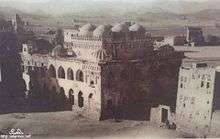Qadad

The Amiriya School, built of qadad
Qadad (Qadâd, Kʉðað) is a waterproof plaster surface, made of a lime plaster treated with slaked lime and oils and fats. The technique is well over a millennium old[1] and can be used as a roof covering.[2]
.jpg)
A minaret of the over 1300-year-old Great Mosque of Sana'a in Yemen, which is built with qadad. It is now being restored
Due to the slowness of some of the chemical reactions, qadad mortar can take over a hundred days to prepare, from quarrying of raw materials to the beginning of application to the building. It can also take over a year to set fully.[3]

Close-up of part of the restored Amiriya Complex
In 2004, a documentary film Qudad, Re-inventing a Tradition was made by the filmmaker Caterina Borelli (preview).[4] It documents the restoration of the Amiriya Complex, which was awarded the Aga Khan Award for Architecture in 2007.[5]
See also
References
- ↑ see Great Mosque of Sana'a
- ↑ Sutter, Anita (18 December 2006). "Note sur la fabrication du qadâd". Arabian Humanities. Retrieved 13 February 2016.
- ↑ http://intarch.ac.uk/journal/issue20/reviews/fodde.html
- ↑ "Qudad, Re-inventing a Tradition". Documentary Educational Resources.
- ↑ Aga Khan Award website
This article is issued from Wikipedia - version of the 10/9/2016. The text is available under the Creative Commons Attribution/Share Alike but additional terms may apply for the media files.